
26 minute read
President Donald J. Trump Awarding America’s Best the Medal of Honor
Former US President Harry S Truman said he would rather have the Medal of Honor than be president of the
Advertisement
United States. No wonder. The Medal of Honor (MOH) is the most prestigious and highest ranked US military award bestowed for bravery on the battlefield.
It is also the hardest to earn. There have been only 3,525 MOHs awarded since its establishment. Sadly, 624 of them have been awarded posthumously. The number of awards pales in comparison to the plethora of stories that compose the medal’s glorious history.
The Medal of Honor dates to 1861. The Army and Navy needed a medal for bravery for US Warfighters during the American Civil War. Traditionally, awards for battlefield bravery had never been a priority for the either service. The few available prior to the Civil War were temporary in nature and not always associated with honor or bravery.
I WILL ALWAYS PLACE THE MISSION FIRST I WILL NEVER ACCEPT DEFEAT I WILL NEAVER QUIT I WILL NEVER LEAVE A FALLEN COMRADE UNITED STATES ARMY
US Army Photo by Sergeant Kevin Roy.
President Donald J Trump presents the Medal of Honor to US Army Master Sergeant Matthew O Williams during a ceremony at the White House in Washington, DC, 30 October 2019. Photo Credit: Sergeant Keisha Brown.
SERGEANT MATTHEW O WILLIAMS
Sergeant Matthew O Williams distinguished himself by acts of gallantry and intrepidity above and beyond the call of duty on 6 April 2008, while serving as a Weapons Sergeant, Special Forces Operational Detachment Alpha 3336, Special Operations Task Force-33, in support of OPERATION ENDURING FREEDOM. Sergeant Williams was part of an assault element inserted by helicopter into a location in Afghanistan. As the assault element was moving up a mountain toward its objective, it was engaged by intense enemy machine gun, sniper, and rocket-propelled grenade fire. The lead portion of the assault element, which included the ground commander, sustained several casualties, and became pinned down on the sheer mountainside. Sergeant Williams, upon hearing that the lead element had sustained casualties and was in danger of being overrun, braved intense enemy fire to lead a counterattack across a valley of icecovered boulders and a fast-moving, ice cold, and waist-deep river. Under withering fire, Sergeant Williams and his local national commandos fought up the terraced mountainside to the besieged element. Arriving at the lead element’s position, Sergeant Williams arrayed his Afghan commandos to provide suppressive fire, which kept the insurgent fighters from overrunning the position. When the Team Sergeant was wounded, Sergeant Williams braved enemy fire once again to provide buddyaid and to move the Team Sergeant down the sheer mountainside to the casualty collection point. Sergeant Williams then fought and climbed his way back up the mountainside to help defend the lead g

assault element that still had several serious casualties in need of evacuation. Sergeant Williams directed suppressive fire and exposed himself to enemy fire in order to reestablish the team’s critical satellite radio communications. He then assisted with moving the wounded down the near-vertical mountainside to the casualty collection point. Noting that the collection point was about to be overrun by enemy fighters, Sergeant Williams led the Afghan commandos in a counterattack that lasted for several hours. When helicopters arrived to evacuate the wounded, Sergeant Williams again exposed himself to enemy fire, carrying and loading casualties onto the helicopters while continuing to direct commando firepower to suppress numerous insurgent positions. His actions enabled the patrol to evacuate wounded and dead comrades without further casualties. Sergeant Williams’ complete disregard for his own safety and his concern for the safety of his teammates ensured the survival of four critically wounded soldiers and prevented the lead element of the assault force from being overrun by the enemy. Sergeant Williams’ actions are in keeping with the finest traditions of military service and reflect great credit upon himself, Combined Joint Special Operations Task Force-Afghanistan, Special Operations Command Central, and the United States Army.
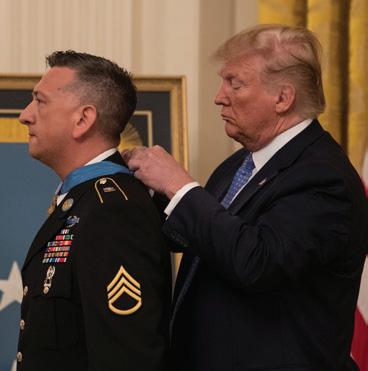
President Donald J Trump presents the Medal of Honor to Staff Sergeant David G Bellavia during a ceremony at the White House in Washington, DC, 25 June 2019. US Army Photo by Sergeant Kevin Roy.
STAFF SERGEANT DAVID G BELLAVIA
Staff Sergeant David G Bellavia distinguished himself by acts of gallantry and intrepidity above and beyond the call of duty on 10 November 2004, while serving as a squad leader in support of OPERATION PHANTOM FURY in Fallujah, Iraq. While clearing a house, a squad from Staff Sergeant Bellavia’s platoon became trapped within a room by intense enemy fire coming from a fortified position under the stairs leading to the second floor. Recognizing the immediate severity of the situation, and with disregard for his own safety, Staff Sergeant Bellavia retrieved an automatic weapon and entered the doorway of the house to engage the insurgents. With enemy rounds impacting around him, Staff Sergeant Bellavia fired at the enemy position at a cyclic rate, providing covering fire that allowed the squad to break contact and exit the house. A Bradley Fighting Vehicle was brought forward to suppress the enemy; however, due to high walls surrounding the house, it could not fire directly at the enemy position. Staff Sergeant Bellavia then re-entered the house and again came under intense enemy fire. He observed an enemy insurgent preparing to launch a rocket-propelled grenade at his platoon. Recognizing the grave danger the grenade posed to his fellow soldiers, Staff Sergeant Bellavia assaulted the enemy position, killing one insurgent and wounding another who ran to a different part of the house. Staff Sergeant Bellavia, realizing he had an un-cleared, darkened room to his back, moved to clear it. As he entered, an insurgent came down the stairs firing at him. Simultaneously, the previously wounded insurgent reemerged and engaged Staff Sergeant Bellavia. Staff Sergeant Bellavia, entering further into the darkened room, returned fire and eliminated both insurgents. Staff Sergeant Bellavia then received enemy fire from another insurgent emerging from a closet in the darkened room. Exchanging gunfire, Staff Sergeant Bellavia pursued the enemy up the stairs and eliminated him. Now on the second floor, Staff Sergeant Bellavia moved to a door that opened onto the roof. At this point, a fifth insurgent leapt from the thirdfloor roof onto the second-floor roof. Staff Sergeant Bellavia engaged the insurgent

through a window, wounding him in the back and legs, and caused him to fall off the roof. Acting on instinct to save the members of his platoon from an imminent threat, Staff Sergeant Bellavia ultimately cleared an entire enemy-filled house, destroyed four insurgents, and gravely wounded a fifth. Staff Sergeant Bellavia’s bravery, complete disregard for his own safety, and unselfish and courageous actions are in keeping with the finest traditions of military service and reflect great credit upon himself and the United States Army.
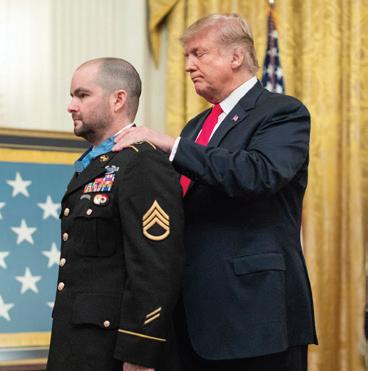

US Army photo by Specialist James Harvey.

President Donald J Trump posthumously awards the Medal of Honor to Staff Sergeant Travis W. Atkins at the White House in Washington DC, 27 March 2019. Atkins’ son, Trevor Oliver, speaks to those in attendance at the ceremony. Atkins was posthumously awarded the Medal of Honor for actions while serving with Delta Company, 2nd Battalion, 14th Infantry Regiment, 2nd Brigade Combat Team, 10th Mountain Division, in Abu Sarnak, Iraq. US Army photo by Specialist James Harvey.
STAFF SERGEANT TRAVIS W ATKINS
Staff Sergeant Travis W Atkins distinguished himself by acts of gallantry and intrepidity above and beyond the call of duty on 1 June 2007, while serving in the position of Squad Leader with Company D, 2d Battalion, 14th Infantry Regiment, 2d Brigade Combat Team, 10th Mountain Division, in support of OPERATION IRAQI FREEDOM. While manning a static observation post in the town of Abu Samak, Iraq, Staff Sergeant Atkins was notified that four suspicious individuals, walking in two pairs, were crossing an intersection not far from his position. Staff Sergeant Atkins immediately moved his squad to interdict the individuals. One of the individuals began behaving erratically, prompting Staff Sergeant Atkins to disembark from his patrol vehicle and approach to conduct a search. Both individuals responded belligerently toward Staff Sergeant Atkins, who then engaged the individual he had intended to search in hand-to-hand combat. Staff Sergeant Atkins tried to wrestle the insurgent’s arms behind his back. When he noticed the insurgent was reaching for something under his clothes, Staff Sergeant Atkins immediately wrapped him in a bear hug and threw him to the ground, away from his fellow soldiers. Staff Sergeant Atkins maintained his hold on the insurgent, placing his body on top of him, further sheltering his patrol. With Staff Sergeant Atkins on top of him, the insurgent detonated a bomb strapped to his body, killing Staff Sergeant Atkins. Staff Sergeant Atkins acted with complete disregard for his own safety. In this critical and selfless act of valor, Staff Sergeant Atkins saved the lives of the three other soldiers who were with him and gallantly gave his life for his country. Staff Sergeant Atkins’ undaunted courage, warrior spirit, and steadfast devotion to duty are in keeping with the highest traditions of military service and reflect great credit upon himself, the 2d Brigade Combat Team, and the United States Army.
White House Photo by Shealah Craighead.
The Medal of Honor is presented to former US Army Staff Sergeant Ronald J Shurer II during a ceremony at the White House in Washington, DC, 1 October 2018. White House Photo by Shealah Craighead.
STAFF SERGEANT RONALD J SHURER II
Staff Sergeant Ronald J Shurer II distinguished himself by acts of gallantry and intrepidity above and beyond the call of duty on 6 April 2008, while serving as a Senior Medical Sergeant, Special Forces Operational Detachment Alpha g

3336, Special Operations Task Force-33, in support of OPERATION ENDURING FREEDOM. Staff Sergeant Shurer was part of an assault element inserted by helicopter into a location in Afghanistan. As the assault element moved up a near vertical mountain toward its objective, it was engaged by fierce enemy machine gun, sniper, and rocketpropelled grenade fire. The lead portion of the assault element, which included the ground commander, sustained several casualties, and became pinned down on the mountainside. Staff Sergeant Shurer and the rest of the trailing portion of the assault element were likewise engaged by enemy machine gun, sniper, and rocket-propelled grenade fire. As the attack intensified, Staff Sergeant Shurer braved enemy fire to move to an injured Soldier and treat his wounds. Having stabilized the injured Soldier, Staff Sergeant Shurer then learned of the casualties among the lead element. Staff Sergeant Shurer fought his way up the mountainside, under intense enemy fire, to the lead element’s location. Upon reaching the lead element, he treated and stabilized two more Soldiers. Finishing those lifesaving efforts, Staff Sergeant Shurer noticed two additional severely wounded Soldiers under intense enemy fire. The bullet that had wounded one of these Soldiers had also impacted Staff Sergeant Shurer’s helmet. With complete disregard for his own life, Staff Sergeant Shurer again moved through enemy fire to treat and stabilize one Soldier’s severely wounded arm. Shortly thereafter, Staff Sergeant Shurer continued to brave withering enemy fire to get to the other Soldier’s location in order to treat his lower leg, which had been almost completely severed by a high-caliber sniper round. After treating the Soldier, Staff Sergeant Shurer began to evacuate the wounded, carrying and lowering them down the sheer mountainside. While moving down the mountain, Staff Sergeant Shurer used his own body to shield the wounded from enemy fire and debris caused by dangerclose air strikes. Reaching the base of the mountain, Staff Sergeant Shurer set up a casualty collection point and continued to treat the wounded. With the arrival of the medical evacuation helicopter, Staff Sergeant Sharer, again under enemy fire, helped load the wounded into the helicopter. Having ensured the safety of the wounded, Staff Sergeant Shurer then regained control of his commando squad and rejoined the fight. He continued to lead his troops and emplace security elements until it was time to move to the evacuation landing zone for the helicopter. Staff Sergeant Shurer’s actions are in keeping with the finest traditions of military service and reflect great credit upon himself, Combined Joint Special Operations Task Force-Afghanistan, Special Operations Command Central, and the United States Army. In 2020 Staff Sergeant Ronald J Shurer II died due to lung cancer.

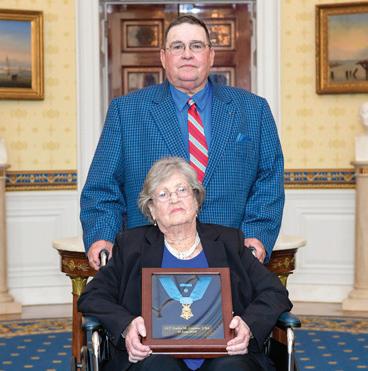

US Army photo by Specialist Anna Pol.
Pauline Lyda Wells Conner, the spouse of US Army 1st Lieutenant Garlin M Conner, and their son Paul Conner, at the White House in Washington, DC, 26 June 2018. Conner was posthumously awarded the Medal of Honor for actions while serving as an intelligence officer during World War II, 24 January 1945. US Army photo by Specialist Anna Pol.
FIRST LIEUTENANT GARLIN M CONNER
First Lieutenant Garlin M Conner distinguished himself by acts of gallantry and intrepidity while serving with Company K, 3d Battalion, 7th Infantry Regiment, 3d Infantry Division. On the morning of 24 January 1945, near the town of Houssen, France, German forces ferociously counterattacked the front left flank of the 7th Infantry Regiment with 600 infantry troops, six Mark VI tanks, and tank destroyers. Lieutenant Conner, having recently returned to his unit after recovering from a wound received in an earlier battle, was working as the Intelligence Officer in the 3d Battalion Command Post at the time of the attack. Understanding the devastating effect that the advancing enemy armor could have on the Battalion, Lieutenant Conner immediately volunteered to run straight into the heart of the enemy assault to get to a position from which he could direct friendly artillery on the advancing enemy forces. With complete disregard for his own safety, Lieutenant Conner maneuvered 400 yards through enemy artillery fire that destroyed trees in his path and rained shrapnel all around him, while unrolling telephone wire needed to communicate with the Battalion command post. Upon reaching the Battalion’s front line, he continued to move forward under the enemy assault to a position 30 yards in front of the defending United States forces, where he plunged into a shallow ditch that provided minimal protection from the advancing enemy’s heavy machine gun and small arms fire. With rounds impacting all around him, Lieutenant Conner calmly directed multiple fire missions, adjusting round after round of artillery from his prone position, until the enemy was forced to halt its advance and seek cover behind a nearby dike. For three hours, Lieutenant Conner remained in this compromised position, enduring the repeated onslaught of German infantry which, at one point, advanced to within five yards of his position. As German infantry regrouped and began to mass in an overwhelming assault, Lieutenant Conner ordered friendly artillery to concentrate directly on his own position, having resolved to die if necessary, to destroy the enemy advance. Ignoring the friendly artillery shells blanketing his position and exploding mere feet from him, Lieutenant Conner continued to direct artillery fire on the enemy assault swarming g


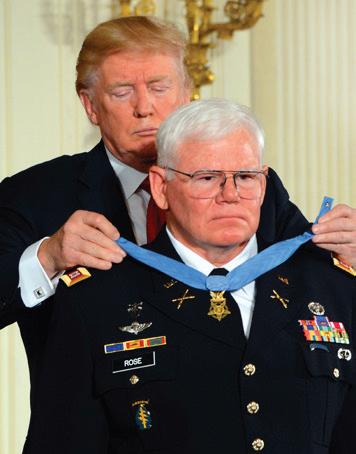
around him until the German attack was finally broken. By his heroism and disregard for his own life, Lieutenant Conner stopped the enemy advance. The artillery he expertly directed, while under constant enemy fire, killed approximately fifty German soldiers and wounded an estimated one hundred more, preventing what would have undoubtedly been heavy friendly casualties. His actions are in keeping with the highest traditions of military service and reflect great credit upon himself, the 3d Infantry Division, and the United States Army.
US Army photo by C. Todd Lopez.
President Donald Trump places the Medal of Honor around the neck of Captain Mike Rose, during a 23 October 2017 ceremony at the White House, in Washington, DC. US Army Photo by C Todd Lopez.
SERGEANT GARY M ROSE
Sergeant Gary M Rose distinguished himself by acts of gallantry and intrepidity while serving as a Special Forces Medic with a company-sized exploitation force, Special Operations Augmentation, Command and Control Central, 5th Special Forces Group (Airborne), 1st Special Forces, Republic of g
Vietnam. Between 11 and 14 September 1970, Sergeant Rose’s company was continuously engaged by a well-armed and numerically superior hostile force deep in enemy-controlled territory. Enemy B-40 rockets and mortar rounds rained down while the adversary sprayed the area with small arms and machine gun fire, wounding many and forcing everyone to seek cover. Sergeant Rose, braving the hail of bullets, sprinted fifty meters to a wounded soldier’s side. He then used his own body to protect the casualty from further injury while treating his wounds. After stabilizing the casualty, Sergeant Rose carried him through the bullet-ridden combat zone to protective cover. As the enemy accelerated the attack, Sergeant Rose continuously exposed himself to intense fire as he fearlessly moved from casualty to casualty, administering life-saving aid. A B-40 rocket impacted just meters from Sergeant Rose, knocking him from his feet and injuring his head, hand, and foot. Ignoring his wounds, Sergeant Rose struggled to his feet and continued to render aid to the other injured soldiers. During an attempted medevac, Sergeant Rose again exposed himself to enemy fire as he attempted to hoist wounded personnel up to the hovering helicopter, which was unable to land due to unsuitable terrain. The medevac mission was aborted due to intense enemy fire and the helicopter crashed a few miles away due to the enemy fire sustained during the attempted extraction. Over the next two days, Sergeant Rose continued to expose himself to enemy fire in order to treat the wounded, estimated to be half of the company’s personnel. On 14 September, during the company’s eventual helicopter extraction, the enemy launched a full-scale offensive. Sergeant Rose, after loading wounded personnel on the first set of extraction helicopters, returned to the outer perimeter under enemy fire, carrying friendly casualties and moving wounded personnel to more secure positions until they could be evacuated. He then returned to the perimeter to help repel the enemy until the final extraction helicopter arrived. As the final helicopter was loaded, the enemy began to overrun the company’s position, and the helicopter’s Marine door gunner was shot in the neck. Sergeant Rose instantly administered critical medical treatment onboard the helicopter, saving the Marine’s life. The helicopter carrying Sergeant Rose crashed several hundred meters from the evacuation point, further injuring Sergeant Rose and the personnel on board. Despite his numerous wounds from the past three days, Sergeant Rose continued to pull and carry unconscious and wounded personnel out of the burning wreckage and continued to administer aid to the wounded until another extraction helicopter arrived. Sergeant Rose’s extraordinary heroism and selflessness above and beyond the call of duty were critical to saving numerous lives over that four-day time period. His actions are in keeping with the highest traditions of military service and reflect great credit upon himself, the 1st Special Forces, and the United States Army.
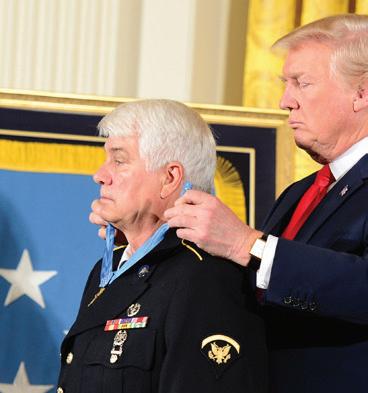
US Army photo by Eboni Everson-Myart.
President Donald J Trump hosts the Medal of Honor ceremony for former Specialist Five James C McCloughan at the White House in Washington, DC, 31 July 2017. US Army photo by Eboni Everson-Myart.
PRIVATE FIRST-CLASS JAMES C MCCLOUGHAN
Private First Class James C McCloughan distinguished himself by acts of gallantry and intrepidity at the risk of his life above and beyond the call of duty from 13 -15 May 1969, while serving as a combat medic with Company C, 3d Battalion, 21st Infantry, 196th Light Infantry Brigade, Americal Division. The company air assaulted into an area near Tam Ky and Nui Yon Hill. On 13 May, with complete disregard for his life, he ran 100 meters in an open field through heavy fire to rescue a comrade too injured to move and carried him to safety. That same day, 2d Platoon was ordered to search the area near Nui Yon Hill when the platoon was ambushed by a large North Vietnamese Army force and sustained heavy casualties. With complete disregard for his life and

personal safety, Private First-Class McCloughan led two Americans into the safety of a trench while being wounded by shrapnel from a rocket propelled grenade. He ignored a direct order to stay back and braved an enemy assault while moving into the “kill zone” on four more occasions to extract wounded comrades. He treated the injured, prepared the evacuation, and though bleeding heavily from shrapnel wounds on his head and body, refused evacuation to safety in order to remain at the battle site with his fellow Soldiers who were heavily outnumbered by North Vietnamese Army forces. On 14 May, the platoon was again ordered to move out towards Nui Yon Hill. Private First-Class McCloughan was wounded a second time by small arms fire and shrapnel from a rocket propelled grenade while rendering aid to two Soldiers in an open rice paddy. In the final phases of the attack, two companies from the 2nd North Vietnamese Army Division and an element of 700 soldiers from a Viet Cong regiment descended upon Company C’s position on three sides. Private First-Class McCloughan, again with complete disregard for his life, went into the crossfire numerous times throughout the battle to extract wounded Soldiers, while also fighting the enemy. His relentless and courageous actions inspired and motivated his comrades to fight for their survival. When supplies ran low, Private First-Class McCloughan volunteered to hold a blinking strobe light in an open area as a marker for a nighttime resupply drop. He remained steadfast while bullets landed all around him and rocket propelled grenades flew over his prone, exposed body. During the morning darkness of 15 May, Private First Class McCloughan knocked out a rocket propelled grenade position with a grenade, fought and eliminated enemy soldiers, treated numerous casualties, kept two critically wounded Soldiers alive during the night, and organized the dead and wounded for evacuation at daylight. His timely and courageous actions were instrumental in saving the lives of his fellow Soldiers. Private FirstClass McCloughan’s personal heroism, professional competence, and devotion to duty are in keeping with the highest traditions of the military service and reflect great credit upon himself, the America l Division, and the United States Army.
Medals of Honor are awarded sparingly and are bestowed only to the bravest of the brave; and that courage must be well documented. Other recent Army Medal of Honor Recipients are:

Lieutenant Colonel Charles Kettles Captain Florent Groberg Sergeant Henry Johnson Sergeant William Shemin 1st Lieutenant Alonzo H Cushing Command Sergeant Major Bennie G Adkins Specialist 4 Donald Sloat Staff Sergeant Ryan M Pitts Sergeant Kyle J White Captain William D Swenson Staff Sergeant Ty Michael Carter Staff Sergeant Clinton L Romesha Sergeant 1st Class Leroy A Petry Staff Sergeant Salvatore A Giunta Staff Sergeant Robert J Miller Sergeant 1st Class Jared C Monti Private 1st Class Ross McGinnis Sergeant 1st Class Paul R Smith
Since 1998 at least 15 other Medals of Honor have been awarded to correct past administrative errors, oversights, and follow-up on lost recommendations or because of new evidence.
Here are just a few examples of Soldiers who were awarded the Medal of Honor from three wars. Their actions, like the other recipients of the medal, were far and above the call of duty.
During the Civil War, the job of color bearer was one of the most hazardous as well as important duties in the Army. Soldiers looked to the flag for direction and inspiration in battle and the bearer was usually out in front, drawing heavy enemy fire while holding the flag high. On 16 November 1863, regimental color bearer Private Joseph E. Brandle, from the 17th Michigan Infantry, participated in a battle near Lenoire, Tennessee. “Having been twice wounded and the sight of one eye destroyed, he still held to the colors until ordered to the rear by his regimental commander.” g
Corporal Alvin C York, from the 82nd Division, fearlessly engaged the numerically superior German force at Chatel-Chehery, France, on 8 October 1918 – just a month before the armistice was signed. His citation reads: “...After his platoon had suffered heavy casualties and three other noncommissioned officers had become casualties, Corporal York assumed command. Fearlessly leading seven men, he charged with great daring toward a machine gun nest, which was pouring deadly and incessant fire upon his platoon. In this heroic feat the machine gun nest was taken, together with four officers and 128 men and several guns.”

Valor is found across the times as well as across the ranks, as World War II 2nd Lieutenant Robert Craig, from the 3rd Infantry Division, demonstrated. According to his citation, 2nd Lieutenant Craig volunteered to defeat an enemy machine gun that three other officers before him could not. He quickly located the gun outside of Favoratta, Sicily, but without cover, he and his men found themselves vulnerable to approximately 100 enemies. “Electing to sacrifice himself so that his platoon might carry on the battle, he ordered his men to withdraw... while he drew the enemy fire to himself. With no hope of survival, he charged toward the enemy until he was within 25 yards of them. Assuming a kneeling position, he killed five and wounded three enemy soldiers. While the hostile force concentrated fire on him, his platoon reached the cover of the crest. 2nd Lieutenant Craig was killed by enemy fire, but his intrepid action so inspired his men that they drove the enemy from the area, inflicting heavy casualties on the hostile force.”
UNITED STATES MARINE CORPS

MAJOR JOHN L CANLEY
Sergeant Major John L. Canley will receive the Medal of Honor for his actions from January 31 to February 6, 1968, while assigned to Company A, First Battalion, First Marines in the Republic of Vietnam. While serving as Company Gunnery Sergeant, he fought off multiple enemy attacks as his company moved along a highway toward Hue City to relieve friendly forces who were surrounded. On several occasions, despite his own wounds, he rushed across fireswept terrain to carry wounded Marines to safety. When his commanding officer was severely wounded, he took command and led his company into Hue City. While in command of the company for three days, he led attacks against multiple enemy-fortified positions while exposing himself to enemy fire to carry wounded Marines to safety. On 6 February, at a hospital compound, he twice scaled a wall in full view of the enemy to aid wounded Marines and carry them to safety. Then-Gunnery Sergeant Canley’s heroic actions saved the lives of his teammates.
UNITED STATES NAVY
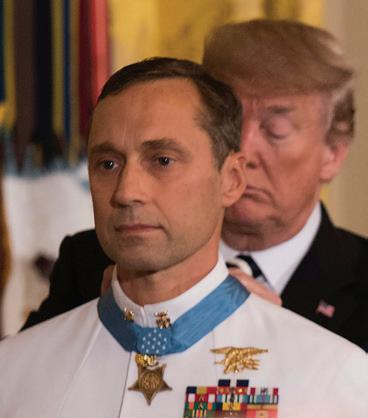
MASTER CHIEF SPECIAL WARFARE OPERATION BRITT K SLABINSKI
As a Team Leader assigned to a Joint Task Force, in the early morning hours of 4 March 2002, then-Senior Chief Slabinski led a reconnaissance team to its assigned observation area on a snow covered, 10,000-foot mountaintop in support of a major coalition offensive against Al-Qaida forces in the valley below. Rocket-propelled grenades and small arms fired from enemy fighters hidden and entrenched in the tree lines and rocks riddled the team’s insertion helicopter. One teammate was ejected from the aircraft, and the crippled helicopter crash landed on the valley floor below. Then-Senior Chief Slabinski boldly rallied his remaining team and organized supporting assets for a daring assault back to the mountain peak in an attempt to rescue their stranded teammate. Later, after a second enemyopposed insertion, then-Senior Chief Slabinski led his six-man joint team up a snow-covered hill, in a frontal assault against two bunkers under withering enemy fire from three directions. He repeatedly exposed himself to enemy fire as he engaged in a pitched, close-quarters firefight against the tenacious and more heavily armed enemy forces. Proximity made air support impossible, and after several teammates became casualties, the situation became untenable.

Senior Chief Slabinski maneuvered his team to a more defensible position, directed air strikes in very close proximity to his team’s position, and requested reinforcements. As daylight approached, the accurate enemy mortar fire forced the team further down the sheer mountainside. Carrying a seriously wounded teammate down a sheer cliff face, he led an arduous trek across one kilometer of precipitous terrain, through waist-deep snow while continuing to call fire on the enemy who was engaging the team from the surrounding ridges. During the subsequent 14 hours, he stabilized casualties on his team and continued the fight against the enemy until the mountaintop was secured by the quick reaction force and his team was extracted.
UNITED STATES AIR FORCE
TECHNICAL SERGEANT JOHN A CHAPMAN
Sergeant Chapman’s spouse, Valerie Nessel, and family will join the President at the White House to commemorate his example of selfless service and sacrifice.
Sergeant John A Chapman will receive the Medal of Honor posthumously for his actions on 4 March 2002, on Takur Ghar mountain in Afghanistan. During a helicopter insertion, Sergeant Chapman’s aircraft came under heavy enemy fire and was hit by a rocket-propelled grenade. One teammate was ejected from the aircraft, and the crippled helicopter crash landed in the valley below. Sergeant Chapman and the remaining joint special operations team members voluntarily returned to the snow-capped mountain, into the heart of a known enemy stronghold, in an attempt to rescue their stranded teammate. Sergeant Chapman charged into enemy fire through harrowing conditions, seized an enemy bunker, and killed its enemy occupants. He then moved from cover to engage a machine gun firing on his team from a second bunker. While engaging this position, he was severely wounded by enemy gunfire. Despite severe wounds, he continued to fight relentlessly, sustaining a violent engagement with multiple enemy personnel before paying the ultimate sacrifice. Sergeant Chapman’s heroic actions, at the cost of his life, are credited with saving the lives of his teammates.

Valerie Nessel, the spouse of Technical Sergeant John Chapman, stands as the citation is read before receiving the Medal of Honor from President Donald J. Trump during a ceremony at the White House in Washington, DC, 2018. Chapman was posthumously awarded the Medal of Honor for actions on Takur Ghar mountain in Afghanistan on 4 March 2002. US Air Force photo by Wayne A. Clark.
Article provide in part by army.mil/medalofhonor, whitehouse.gov and navy.mil.










